Analysis on Consumers’ Purchase and Shopping Well-Being in Online Shopping Carnivals with Two Motivational Dimensions
Abstract
1. Introduction
2. Theoretical Background
2.1. Research on Shopping Motivations
2.2. Factors Influencing the Utilitarian Shopping Value
2.3. Factors Influencing the Hedonic Shopping Value
3. Research Model and Hypotheses
3.1. Impact Factors and the Utilitarian Shopping Value
3.1.1. Monetary Saving
3.1.2. Convenience
3.2. Impact Factors and the Hedonic Shopping Value
3.2.1. Social Interaction
3.2.2. Entertainment
3.3. Shopping Motivational and Intention to Participate in OSC
3.4. Intention to Participate, Actual Purchase and Shopping Well-Being in OSC
3.4.1. Intention to Participate and Actual Purchase
3.4.2. Intention to Participate and Shopping Well-Being
4. Research Design
4.1. Research Instrument
4.2. Data Analysis Methods
4.3. Data Collection and Assessment
5. Results
5.1. Measurement Validity and Reliability
5.2. Structural Model Evaluation
6. Discussion and Conclusions
6.1. Summary of Findings
6.2. Theoretical and Practical Implications
6.3. Limitations and Future Research Direction
Author Contributions
Funding
Acknowledgments
Conflicts of Interest
Appendix A
| Construct | Item | Reference |
|---|---|---|
| Monetary Saving | MS1: I saved money when I shopped during online shopping carnival. MS2: I got my purchases cheaper during online shopping carnival than if I had made them at other times. MS3: I think online shopping carnival offers me quality product in competitive price. | Rintamäki, Kanto, Kuusela, and Spence [48] |
| Selection | SE1: Online shopping carnival is a good period to assess multiple brands. SE2: Online shopping carnival is a good period which offers wide range of products in one time. SE3: Online shopping carnival is favorable for my selection of products. | Chiu et al. [25] |
| Convenience | CO1: Online shopping carnival would allow me to save time when shopping. CO2: I was able to shop as usual without any disturbance or delay. CO3: Participating online shopping carnival to shop is convenient for me. | Childers et al. & Rintamäki et al. [12,48] |
| Entertainment | EN1: I feel online shopping carnival can gratify my shopping needs with fun. EN2: In my opinion, shopping on online shopping carnival was a pleasant way to spend leisure time. EN3: I feel enjoyment and relaxed emotions gained from online shopping carnival. | Rintamäki et al. & Xu et al. [48,4] |
| Social Interaction | SI1: The messages or recommendations of online shopping carnival shared by friends/families get my attention. SI2: When friends/families play incentivized games (e.g., grabbing red envelopes), I’d love to participate in that with them together. SI3: When friends/families purchase some products in online shopping carnival, I feel I want to follow them. | Xu et al. [12,48] |
| Utilitarian Shopping Value | UT1: I accomplished just what I wanted to during online shopping carnival. UT2: While shopping in online shopping carnival, I found just the item(s) I was looking for. UT3: I feel the online shopping carnival trip was utility and effortless. | Babin et al. [9] |
| Hedonic Shopping Value | HE1: The shopping trip of online shopping carnival was truly a joy to me. HE2: I enjoyed this shopping trip for its own sake, not because of that I need to purchase something. HE3: While shopping during online shopping carnival, I was able to forget my unpleasant problems. | Babin et al. [9] |
| Intention to Participate | IN1: I would browse product information and promotional messages provided by marketers during the online shopping carnival. IN2: I would actively search for some product information and participate in marketing activities (e.g., shopping, interactive gaming, and lucky draw) during the online shopping carnival. IN3: It is likely that I will continue participate in online shopping carnival in the future. | Xu et al. [4] |
| Actual Purchase | AP1: How often do you participate and consume in online shopping carnival? (1 = never, 2 = occasionally, 3 = sometimes, 4 = often, 5 = always) AP2: I will buy something every time when I participate in OSC. AP3: How is your spending on online shopping carnival? (1 = very little,2 = little, 3 = general, 4 = much, 5 = very much) | |
| Shopping Well-being | SW1: The online shopping carnival does satisfy my overall shopping needs. SW2: How satisfied you are with your experience of online shopping carnival? SW3: I think the online shopping carnival has contributed my well-being. SW4: I think the money spent on online shopping carnival is worth it. SW5: The online shopping carnival does play an important role in enhancing the quality of my life. | Boven and Gilovich & El Hedhli et al. [49,35] |
References
- Joines, J.L.; Scherer, C.; Scheufele, D.A. Exploring motivations for consumer Web use and their implications for e-commerce. J. Consum. Mark. 2003, 20, 90–108. [Google Scholar] [CrossRef]
- Zhang, R.; Liu, B. Group buying decisions of competing retailers with emergency procurement. Ann. Oper. Res. 2017, 257, 1–17. [Google Scholar] [CrossRef]
- Liao, Y. Analysis of Herd Behavior in Online Shopping—A Case Study of “Double 11 Festival”. J. Guangxi Univ. Natl. 2016, 38, 156–159. [Google Scholar]
- Xu, X.; Li, Q.; Peng, L.; Hsia, T.-L.; Huang, C.-J.; Wu, J.-H. The impact of informational incentives and social influence on consumer behavior during Alibaba’s online shopping carnival. Comput. Hum. Behav. 2017, 76, 245–254. [Google Scholar] [CrossRef]
- Yuan, X.; Chong, T.W.; Krilavičius, T.; Man, K.L. Perceived benefits, risks and trust on Online Shopping Festival. Commun. Comput. Inf. Sci. 2015, 538, 225–235. [Google Scholar]
- Akram, U.; Hui, P.; Khan, M.K.; Hashim, M.; Qiu, Y.; Zhang, Y. Online Impulse Buying on “Double Eleven” Shopping Festival: An Empirical Investigation of Utilitarian and Hedonic Motivations. In Proceedings of the Eleventh International Conference on Management Science and Engineering Management, Kanazawa, Japan, 28–31 July 2017. [Google Scholar]
- Geng, T.; Wang, Y.; Li, Z. Research on the Later Influential Factors of College Students’ Online Shopping Satisfaction in the Network Building Festival. Open J. Soc. Sci. 2016, 4, 11–19. [Google Scholar] [CrossRef]
- Hirschman, E.C.; Holbrook, M.B. Hedonic consumption: Emerging concepts, methods and propositions. J. Mark. 1982, 46, 92–101. [Google Scholar] [CrossRef]
- Babin, B.J.; Darden, W.R.; Griffin, M. Work and/or fun: Measuring hedonic and utilitarian shopping value. J. Consum. Res. 1994, 20, 644–656. [Google Scholar] [CrossRef]
- Li, Y.; Lv, W.; Bai, J. Measuring and evaluating hedonic and utilitarian of consumer attitudes toward two different shopping environments. J. Manag. Sci. 2008, 21, 58–64. [Google Scholar]
- Babin, B.J.; Attaway, J.S. Atmospheric affect as a tool for creating value and gaining share of customer. J. Bus. Res. 2000, 49, 91–99. [Google Scholar] [CrossRef]
- Childers, T.L.; Carr, C.L.; Peck, J.; Carson, S. Hedonic and utilitarian motivations for online retail shopping behavior. J. Retail. 2001, 77, 511–535. [Google Scholar] [CrossRef]
- Bridges, E.; Florsheim, R. Hedonic and utilitarian shopping goals: The online experience. J. Bus. Res. 2008, 61, 309–314. [Google Scholar] [CrossRef]
- Kesari, B.; Atulkar, S. Satisfaction of mall shoppers: A study on perceived utilitarian and hedonic shopping values. J. Retail. Consum. Serv. 2016, 31, 22–31. [Google Scholar] [CrossRef]
- Moon, M.A.; Khalid, M.J.; Awan, H.M.; Attiq, S.; Rasool, H.; Kiran, M. Consumer’s perceptions of website’s utilitarian and hedonic attributes and online purchase intentions: A cognitive–affective attitude approach. Span. J. Mark.-ESIC 2017, 21, 73–88. [Google Scholar] [CrossRef]
- Scarpi, D. Work and Fun on the Internet: The Effects of Utilitarianism and Hedonism Online. J. Interact. Mark. 2012, 26, 53–67. [Google Scholar] [CrossRef]
- Sarkar, A. Impact of utilitarian and hedonic shopping values on individual’s perceived benefits and risks in online shopping. Int. Manag. Rev. 2011, 7, 58–65. [Google Scholar]
- Martínez-López, F.; Pla-García, C.; Gázquez-Abad, J.; Rodriguez-Ardura, I. Hedonic motivations in online consumption behaviour. Int. J. Bus. Environ. 2016, 8, 121–151. [Google Scholar] [CrossRef]
- Mimouni-Chaabane, A.; Volle, P. Perceived benefits of loyalty programs: Scale development and implications for relational strategies. J. Bus. Res. 2010, 63, 32–37. [Google Scholar] [CrossRef]
- Peterson, R.A. Relationship marketing and the consumer. J. Acad. Mark. Sci. 1995, 23, 278–281. [Google Scholar] [CrossRef]
- Chandon, P.; Wansink, B.; Laurent, G. A benefit congruency framework of sales promotion effectiveness. J. Mark. 2000, 64, 65–81. [Google Scholar] [CrossRef]
- To, P.-L.; Liao, C.; Lin, T.-H. Shopping Motivations on Internet: a Study Based on Utilitarian and Hedonic Value. Technovation 2007, 27, 774–787. [Google Scholar]
- Rohm, A.J.; Swaminathan, V. A typology of online shoppers based on shopping motivations. J. Bus. Res. 2004, 57, 748–757. [Google Scholar] [CrossRef]
- Tauber, E. Why Do People Shop? J. Mark. 1972, 36, 46–49. [Google Scholar] [CrossRef]
- Chiu, C.-M.; Wang, E.T.G.; Fang, Y.-H.; Huang, H.-Y. Understanding customers’ repeat purchase intentions in B2C ecommerce—The roles of utilitarian value, hedonic value and perceived risk. Inf. Syst. J. 2014, 24, 85–114. [Google Scholar] [CrossRef]
- Arnold, M.J.; Reynolds, K.E. Hedonic shopping motivations. J. Retail. 2003, 79, 77–95. [Google Scholar] [CrossRef]
- Ajzen, I.; Fishbein, M. Understanding Attitudes and Predicting Social Behavior; Prentice-Hall: Englewood Cliffs, NJ, USA, 1980. [Google Scholar]
- Gupta, S.; Kim, H. Value-driven internet shopping: The mental accounting theory perspective. Psychol. Mark. 2010, 27, 13–35. [Google Scholar] [CrossRef]
- Sweeney, J.C.; Soutar, G.N.; Johnson, L.W. Retail service quality and perceived value: A comparision of two models. J. Retail. Consum. Serv. 1997, 4, 39–48. [Google Scholar] [CrossRef]
- Gohary, A.; Hanzaee, K. Ersonality traits as predictors of shopping motivations and behaviors: a canonical correlation analysis. Arab Econ. Bus. J. 2014, 9, 166–174. [Google Scholar] [CrossRef]
- Rezaei, S.; Ali, F.; Ami, M.; Jayashree, S. Online impulse buying of tourism products: the role of web site personality, utilitarian and hedonic web browsing. J. Hosp. Tourism Technol. 2016, 7, 60–83. [Google Scholar] [CrossRef]
- Klopping, I.M.; McKinney, E. Extending the technology acceptance model and the task-technology fit model to consumer E-commence. Inf. Technol. Learn. Perform. J. 2004, 22, 35–48. [Google Scholar]
- Simester, D. Why great new products fail. Mit Sloan Manag. Rev. 2016, 57, 33–39. [Google Scholar]
- Hsee, C.K.; Yang, Y.; Li, N.; Shen, L. Wealth, warmth, and wellbeing: Whether happiness is relative or absolute depends on whether it is about money, acquisition, or consumption. J. Mark. Res. 2009, 46, 396–409. [Google Scholar] [CrossRef]
- El Hedhli, K.; Chebat, J.-C.; Sirgy, M.J. Shopping well-being at the mall: Construct, antecedents, and consequences. J. Bus. Res. 2013, 66, 856–863. [Google Scholar] [CrossRef]
- Watson, D.; Clark, L.A.; Carey, G. Positive and negative affectivity and their relation to anxiety and depressive disorders. J. Abnormal Psychol. 1988, 97, 346–353. [Google Scholar] [CrossRef]
- Brunstein, J.C.; Schultheiss, O.C.; Grässmann, R. Personal goals and emotional well-being: the moderating role of motive dispositions. J. Personal. Soc. Psychol. 1998, 75, 494–508. [Google Scholar] [CrossRef]
- Hair, J.F.; Hult, G.T.M.; Ringle, C.; Sarstedt, M. A Primer on Partial Least Squares Structural Equation Modeling (PLS-SEM) (2e); Sage Publications: Thousand Oaks, CA, USA, 2017; pp. 20–26. [Google Scholar]
- Hair, J.F.; Sarstedt, M.; Ringle, C.M.; Mena, J.A. An assessment of the use of partial least squares structural equation modeling in marketing research. J. Acad. Mark. Sci. 2012, 40, 414–443. [Google Scholar] [CrossRef]
- Chin, W.W. Commentary: Issues and opinion on structural equation modeling. MIS Q. 1998, 22, vii–xvi. [Google Scholar]
- Henseler, J.; Ringle, C.; Sarstedt, M. A new criterion for assessing discriminant validity in variance-based structural equation modeling. J. Acad. Mark. Sci. 2015, 43, 115–135. [Google Scholar] [CrossRef]
- Valaei, N.; Baroto, M.B. Modelling continuance intention of citizens in government Facebook page: A complementary PLS approach. Comput. Hum. Behav. 2017, 73, 224–237. [Google Scholar] [CrossRef]
- Geisser, S. A predictive approach to the random effect model. Biometrika 1974, 61, 101–107. [Google Scholar] [CrossRef]
- Stone, M. Cross-validatory choice and assessment of statistical predictions. J. R. Stat. Soc. 1974, 36, 111–147. [Google Scholar]
- Lensmire, T. Writing Workshop as Carnival: Reflections on an Alternative Learning Environment. Harv. Educ. Rev. 1994, 64, 371–392. [Google Scholar] [CrossRef]
- Mikalef, P.; Giannakos, M.N.; Pateli, A.G. Exploring the business potential of social media: An utilitarian and hedonic motivation approach. In Proceedings of the 25th Bled eConference eDependability: Reliable and Trustworthy eStructures, eProcesses, eOperations and eServices for the Future, Bled, Slovenia, 17–20 June 2012. [Google Scholar]
- Mikalef, P.; Giannakos, M.N.; Pappas, I.O. Designing social commerce platforms based on consumers’ intentions. Behav. Inf. Technol. 2017, 36, 1308–1327. [Google Scholar]
- Rintamäki, T.; Kanto, A.; Kuusela, H.; Spence, M.T. Decomposing the value of department store shopping into utilitarian, hedonic and social dimensions. Int. J. Retail Distrib. Manag. 2006, 34, 6–24. [Google Scholar] [CrossRef]
- Boven, L.V.; Gilovich, T. To do or to have? That is the question. J. Personal. Soc. Psychol. 2003, 85, 1193–1202. [Google Scholar] [CrossRef] [PubMed]
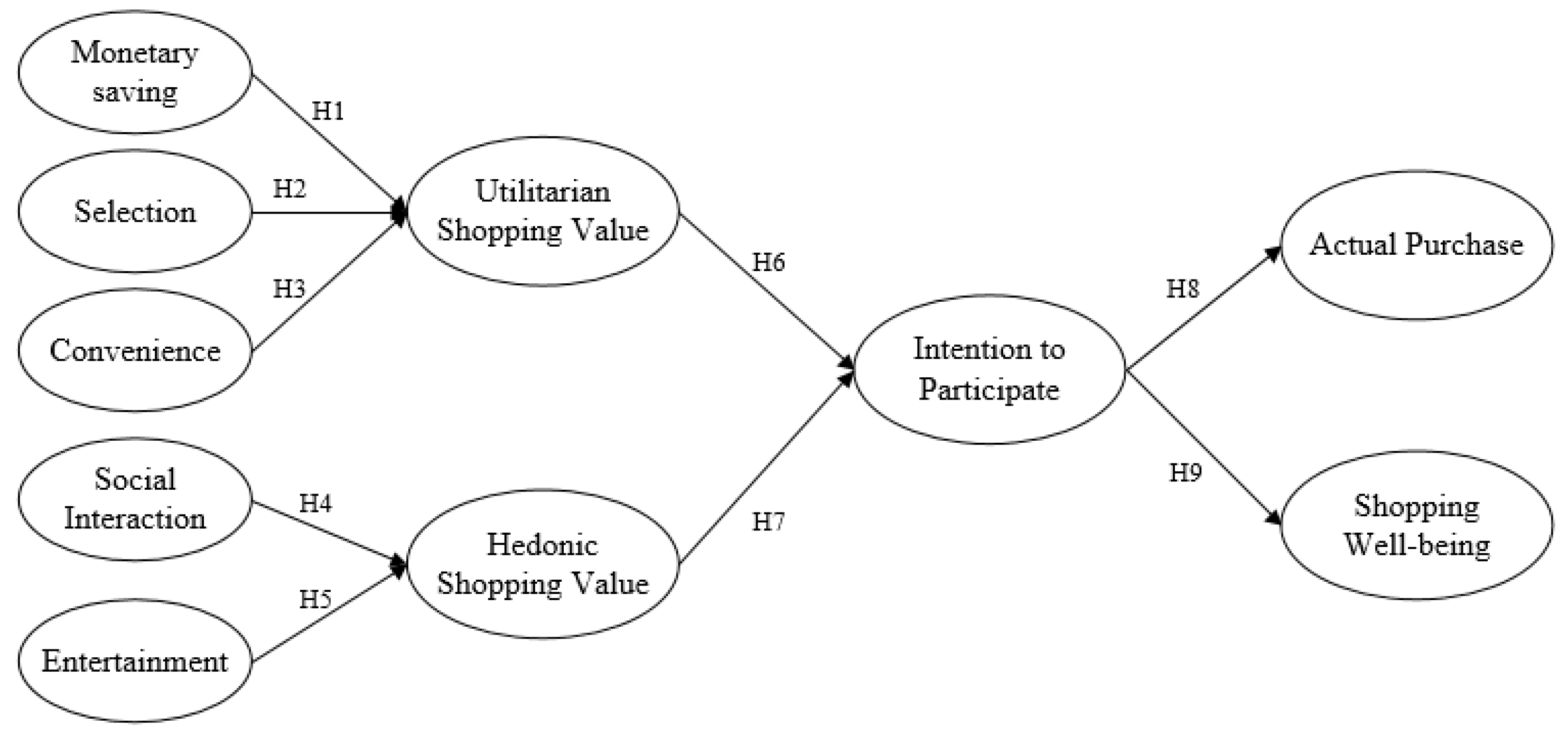
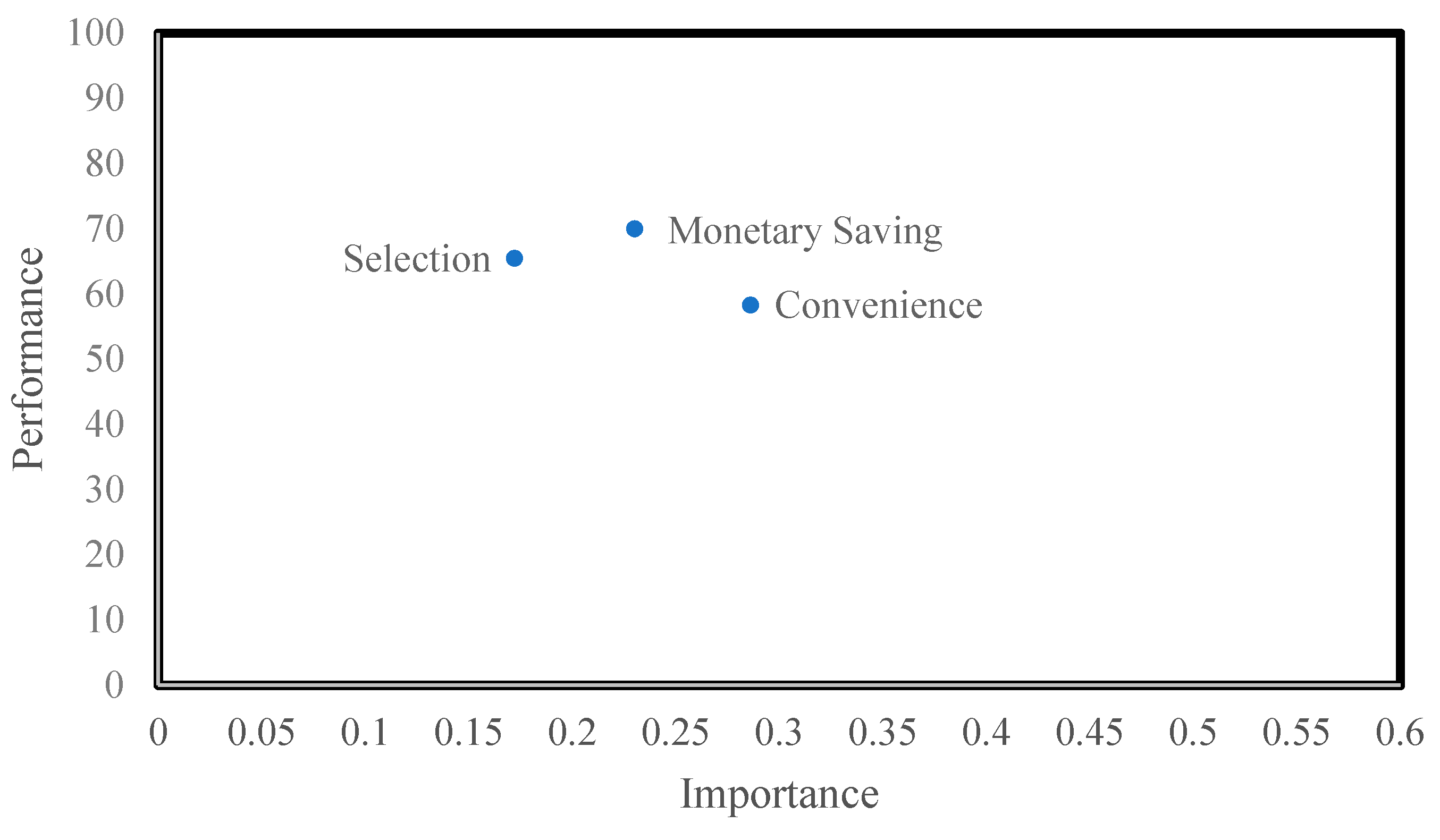
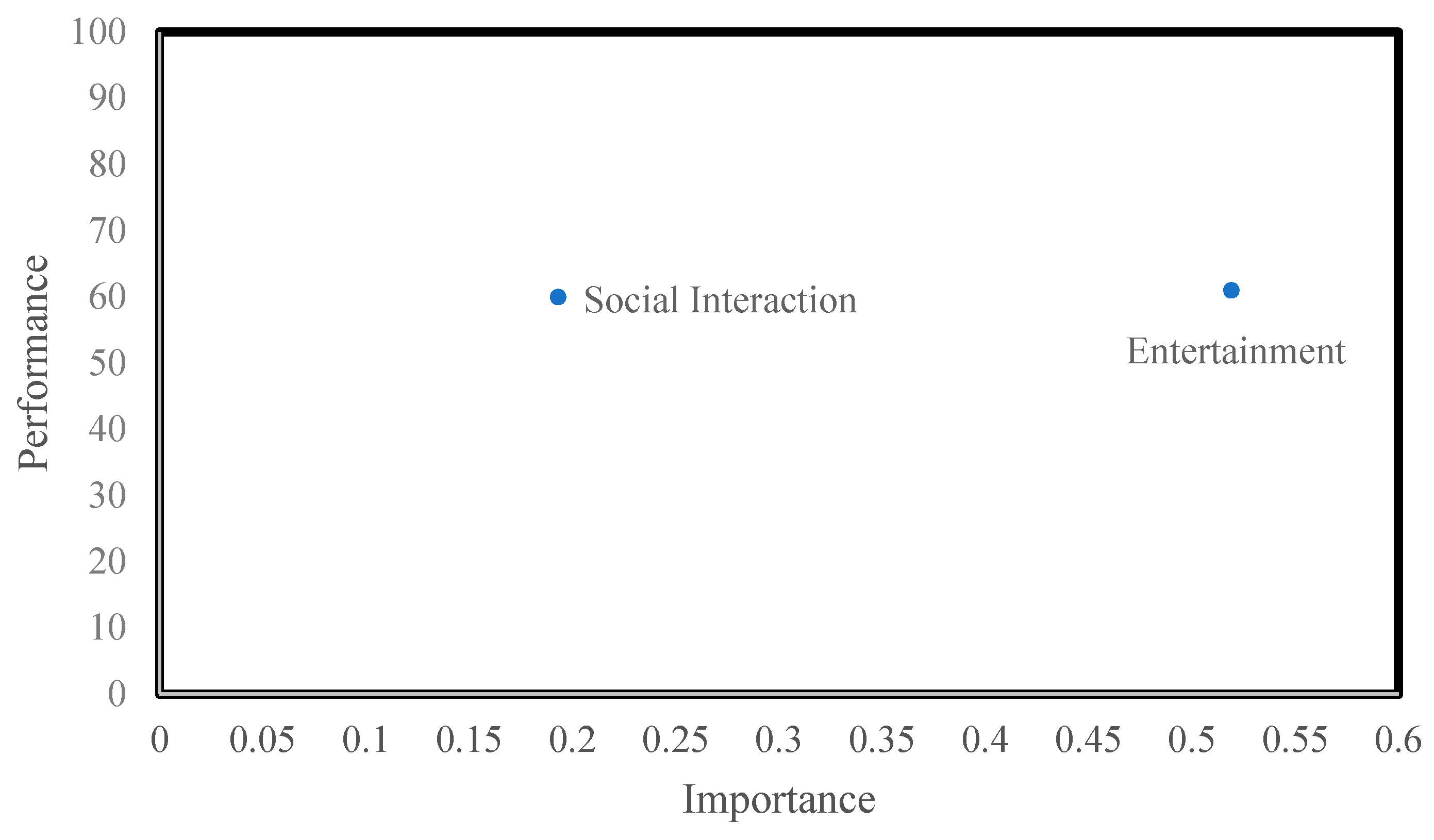
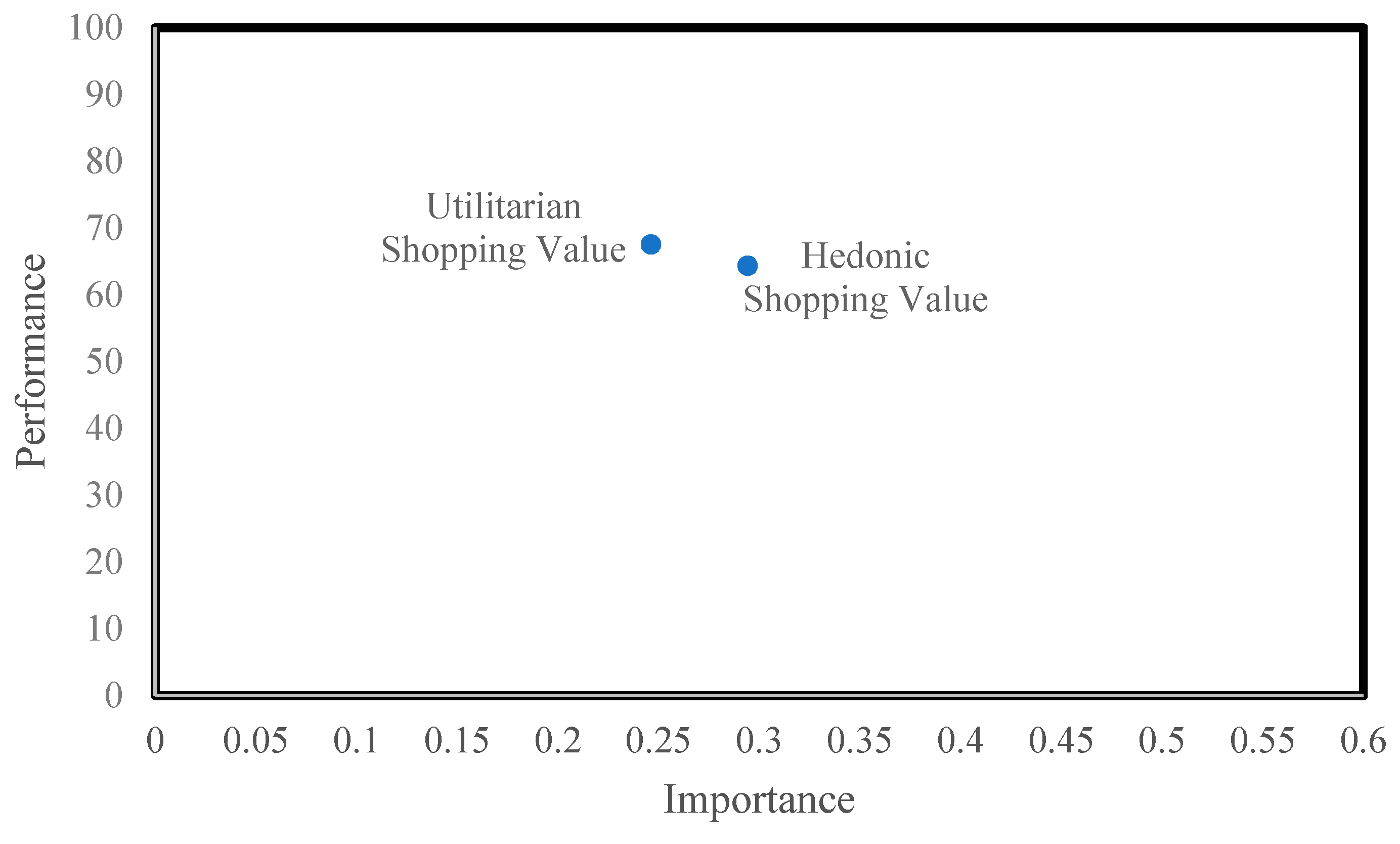
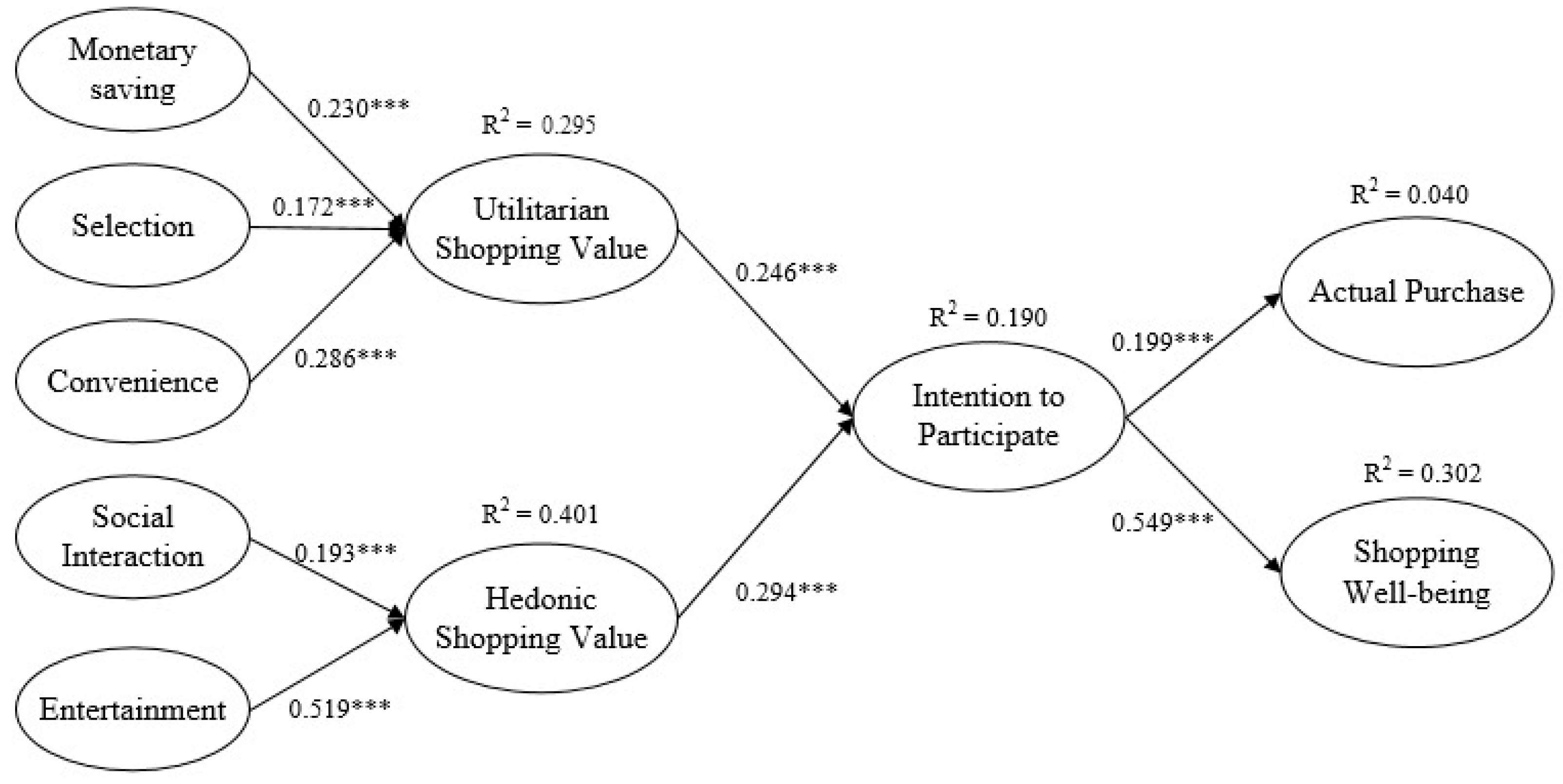
| Year | Sales (100 million yuan) | Year-on-Year Growth |
|---|---|---|
| 2009 | 0.5 | 0% |
| 2010 | 9.36 | 1772% |
| 2011 | 52 | 456% |
| 2012 | 191 | 267% |
| 2013 | 350 | 83% |
| 2014 | 571 | 63% |
| 2015 | 912 | 60% |
| 2016 | 1207 | 32% |
| 2017 | 1682 | 39% |
| 2018 | 2135 | 27% |
| N = 415 | Classification | Number | Percentage |
|---|---|---|---|
| Gender | Male | 141 | 34.0 |
| Female | 274 | 66.0 | |
| Age | 18–25 | 110 | 26.5 |
| 26–30 | 109 | 26.3 | |
| 31–40 | 99 | 23.8 | |
| 41–50 | 65 | 15.7 | |
| Above 50 | 32 | 7.7 | |
| Educational background | Junior high school and below | 13 | 3.1 |
| High school | 86 | 20.7 | |
| Junior college | 49 | 11.8 | |
| Bachelor | 205 | 49.4 | |
| Master and above | 62 | 15.0 | |
| Average monthly income (RMB) | 0–3500 | 198 | 47.7 |
| 3501–7000 | 85 | 20.5 | |
| 7001–12,000 | 88 | 21.2 | |
| 12,001–20,000 | 23 | 5.5 | |
| Above 20,000 | 21 | 5.1 | |
| Participation in OSC (frequency) | 1–3 | 227 | 54.7 |
| 4–6 | 96 | 23.1 | |
| Almost every time | 92 | 22.2 |
| Construct | Item | Outer Loading/Outer Weight | Cronbach’s α | Composite Reliability | Average Variance Extracted (AVE) |
|---|---|---|---|---|---|
| Monetary Saving | MS1 | 0.767 *** | 0.700 | 0.833 | 0.625 |
| MS2 | 0.843 *** | ||||
| MS3 | 0.769 *** | ||||
| Selection | SE1 | 0.806 *** | 0.700 | 0.833 | 0.625 |
| SE2 | 0.785 *** | ||||
| SE3 | 0.780 *** | ||||
| Convenience | CO1 | 0.815 *** | 0.728 | 0.846 | 0.646 |
| CO2 | 0.791 *** | ||||
| CO3 | 0.805 *** | ||||
| Social Interaction | SI1 | 0.832 *** | 0.716 | 0.840 | 0.637 |
| SI2 | 0.774 *** | ||||
| SI3 | 0.786 *** | ||||
| Entertainment | EN1 | 0.741 *** | 0.731 | 0.847 | 0.650 |
| EN2 | 0.850 *** | ||||
| EN3 | 0.823 *** | ||||
| Utilitarian Shopping Value | UT1 | 0.771 *** | 0.703 | 0.832 | 0.624 |
| UT2 | 0.773 *** | ||||
| UT3 | 0.826 *** | ||||
| Hedonic Shopping Value | HE1 | 0.839 *** | 0.736 | 0.847 | 0.650 |
| HE2 | 0.858 *** | ||||
| HE3 | 0.714 *** | ||||
| Intention to Participate | IN1 | 0.770 *** | 0.711 | 0.837 | 0.632 |
| IN2 | 0.768 *** | ||||
| IN3 | 0.845 *** | ||||
| Actual Purchase | AP1 | 0.804 *** | 0.707 | 0.835 | 0.629 |
| AP2 | 0.842 *** | ||||
| AP3 | 0.729 *** | ||||
| Shopping Well-being | SW1 | 0.843/0.561 *** | – | – | 0.513 |
| SW2 | 0.760/0.414 *** | ||||
| SW3 | 0.630/0.196 * | ||||
| SW4 | 0.670/0.124 | ||||
| SW5 | 0.658/0.032 |
| AP | CO | EN | HE | IN | MS | SE | SW | SI | UT | |
|---|---|---|---|---|---|---|---|---|---|---|
| AP | 0.793 | |||||||||
| CO | −0.012 | 0.804 | ||||||||
| EN | 0.194 | 0.365 | 0.806 | |||||||
| HE | 0.137 | 0.395 | 0.610 | 0.806 | ||||||
| IN | 0.199 | 0.135 | 0.454 | 0.367 | 0.795 | |||||
| MS | 0.124 | 0.353 | 0.391 | 0.328 | 0.450 | 0.791 | ||||
| SE | 0.123 | 0.452 | 0.428 | 0.413 | 0.318 | 0.504 | 0.790 | |||
| SW | 0.202 | 0.337 | 0.520 | 0.477 | 0.549 | 0.497 | 0.450 | 0.716 | ||
| SI | 0.089 | 0.248 | 0.470 | 0.437 | 0.458 | 0.386 | 0.352 | 0.447 | 0.798 | |
| UT | 0.032 | 0.447 | 0.379 | 0.299 | 0.333 | 0.418 | 0.419 | 0.393 | 0.282 | 0.790 |
| AP | CO | EN | HE | IN | MS | SE | SI | UT | |
|---|---|---|---|---|---|---|---|---|---|
| AP | |||||||||
| CO | 0.131 | ||||||||
| EN | 0.272 | 0.489 | |||||||
| HE | 0.203 | 0.530 | 0.806 | ||||||
| IN | 0.263 | 0.174 | 0.630 | 0.479 | |||||
| MS | 0.161 | 0.493 | 0.549 | 0.442 | 0.627 | ||||
| SE | 0.178 | 0.620 | 0.599 | 0.548 | 0.446 | 0.720 | |||
| SI | 0.123 | 0.325 | 0.656 | 0.581 | 0.644 | 0.541 | 0.491 | ||
| UT | 0.110 | 0.602 | 0.512 | 0.377 | 0.468 | 0.591 | 0.584 | 0.392 |
| Path | Coefficients (Standard Deviation) | t-Value | VIF | Decision |
|---|---|---|---|---|
| H1: Monetary Saving → Utilitarian Shopping Value | 0.230 (0.046) | 5.000 *** | 1.256 | Supported |
| H2: Selection → Utilitarian Shopping Value | 0.172(0.046) | 3.751 *** | 1.256 | Supported |
| H3: Convenience → Utilitarian Shopping Value | 0.286(0.045) | 6.301 *** | 1.256 | Supported |
| H4: Social Interaction → Hedonic Shopping Value | 0.193 (0.045) | 4.264 *** | 1.284 | Supported |
| H5: Entertainment → Hedonic Shopping Value | 0.519 (0.045) | 11.609 *** | 1.284 | Supported |
| H6: Utilitarian Shopping Value → Intention to Participate | 0.246 (0.047) | 5.258 *** | 1.256 | Supported |
| H7: Hedonic Shopping Value → Intention to Participate | 0.294 (0.046) | 6.431 *** | 1.162 | Supported |
| H8: Intention to Participate → Actual Purchase | 0.199 (0.044) | 4.549 *** | 1.000 | Supported |
| H9: Intention to Participate → Shopping Well-being | 0.549 (0.035) | 16.071 *** | 1.000 | Supported |
© 2018 by the authors. Licensee MDPI, Basel, Switzerland. This article is an open access article distributed under the terms and conditions of the Creative Commons Attribution (CC BY) license (http://creativecommons.org/licenses/by/4.0/).
Share and Cite
Yu, H.; Zhang, R.; Liu, B. Analysis on Consumers’ Purchase and Shopping Well-Being in Online Shopping Carnivals with Two Motivational Dimensions. Sustainability 2018, 10, 4603. https://doi.org/10.3390/su10124603
Yu H, Zhang R, Liu B. Analysis on Consumers’ Purchase and Shopping Well-Being in Online Shopping Carnivals with Two Motivational Dimensions. Sustainability. 2018; 10(12):4603. https://doi.org/10.3390/su10124603
Chicago/Turabian StyleYu, Han, Rong Zhang, and Bin Liu. 2018. "Analysis on Consumers’ Purchase and Shopping Well-Being in Online Shopping Carnivals with Two Motivational Dimensions" Sustainability 10, no. 12: 4603. https://doi.org/10.3390/su10124603
APA StyleYu, H., Zhang, R., & Liu, B. (2018). Analysis on Consumers’ Purchase and Shopping Well-Being in Online Shopping Carnivals with Two Motivational Dimensions. Sustainability, 10(12), 4603. https://doi.org/10.3390/su10124603





